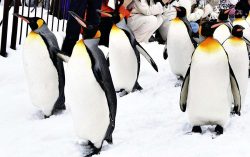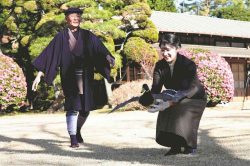
Sculptures are seen at the MUSZIF underwater museum in Isla Fuerte, Bolivar department, Colombia, on May 22.
13:52 JST, July 4, 2024
ISLA FUERTE, Colombia (AFP-Jiji) — On the Caribbean seafloor, an unusual sculpture gallery is taking shape with an equally unusual purpose: to provide homes for corals under threat from tourism and climate change.
Created by potters Hugo Osorio and Pedro Fuentes, 25 figures so far form a sort of artificial reef in the blue waters around the paradisiacal Isla Fuerte, off the coast of Colombia.
They stand 1.5 meters tall, scattered at a depth of about six meters around the seafloor, attracting visitors — mostly fish, but also divers.
The statues have been placed there since 2018 under an initiative named MUSZIF, started by Tatiana Orrego, a fashion designer and island resident.
The plan is for another 25 to follow.
“When I discovered the deterioration of the island’s natural reefs, I saw in the art project a possibility to protect and enhance the life of corals,” Orrego told AFP.
Orrego had seeded the clay sculptures with baby corals, and watched as they took off.
The statues are the “ideal substrate” for the marine invertebrates to grow on, added the creator of Colombia’s first underwater art gallery.
Coral bleaching
Since the beginning of the year, the world has witnessed a massive coral bleaching episode in both the northern and southern hemispheres — the fourth such global event on record and the second in 10 years, according to the U.S. National Oceanic and Atmospheric Administration (NOAA).
These events cause corals to die off, affecting the ecosystems that rely on them as well as tourism and food security.
The culprit, according to the NOAA: warming oceans.
Colombia’s corals are spread over a zone equivalent to 100,000 soccer fields, but more than two-thirds have already suffered from bleaching, according to the environment ministry.
Other problems include damage to reefs by divers and tourists directly.
Tourists have been known to break off pieces of coral to bring to the surface, while others cause damage by walking on the structures.
“People don’t understand that coral is a living being,” said Orrego.
The Isla Fuerte gallery receives about 2,000 human visitors a year.
It offers an “alternative space to take tourists without overloading the natural reefs,” Orrego added.
Osorio and Fuentes, who create the coral-housing statues on Orrego’s commission, base their designs on the ancestral creations of the Zenu people, who inhabited the Colombian Caribbean before the Spanish arrived.
“All this comes from our roots,” Fuentes, 48, told AFP.
“We continue with the culture so that it does not get lost,” added Osorio, 59.
"Science & Nature" POPULAR ARTICLE
-

Mass Oyster Die-Offs Confirmed in Japan’s Seto Inland Sea; High Water Temperature Cited as Primary Cause
-

Genome Study Reveals Milestone in History of Cat Domestication
-

Big Leap in Quest to Get to Bottom of Climate Ice Mystery
-

Security Camera Footage Vulnerable to Outside Access; Investigation Finds 3,000 Pieces Exposed Online
-

Paws on Parade: Nairobi’s Dogs Dazzle at ‘Pawchella’
JN ACCESS RANKING
-

Keidanren Chairman Yoshinobu Tsutsui Visits Kashiwazaki-Kariwa Nuclear Power Plant; Inspects New Emergency Safety System
-

Imports of Rare Earths from China Facing Delays, May Be Caused by Deterioration of Japan-China Relations
-

Japan Pulls out of Vietnam Nuclear Project, Complicating Hanoi’s Power Plans
-

Govt Aims to Expand NISA Program Lineup, Abolish Age Restriction
-

Blanket Eel Trade Restrictions Rejected
























